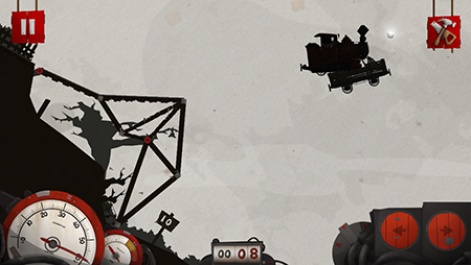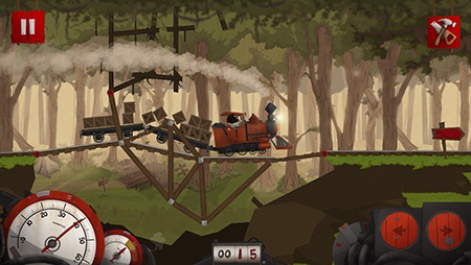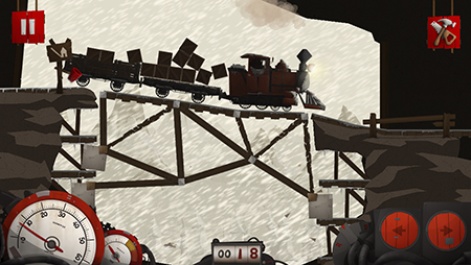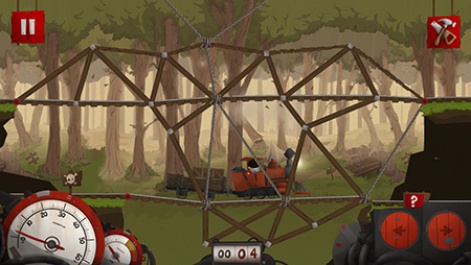In fact, the genre has it stands today began life well over a decade ago, ever since (the imaginatively titled) Bridge Builder from Chronic Logic hit PC and Mac at the turn of the millennium.
With Bridgy Jones, however, Polish developer Grow App decided the bridge building genre wasn't quite living up to its full potential.
It's something project manager Marcin Grochowina is especially open about: he's under no illusion that the core of Bridgy Jones offers something completely fresh, and is aware of the hefty competition within the genre. Yet the studio still believed it could lift bridge building beyond its base.
In the latest of our 'making of' series, Grochowina explains how Grow App set about delivering what many believe is the definitive iOS bridge building game on the market.
Building bridges...
"We couldn't find any other bridge-building game out there that met our expectations, so we decided to make our own," he explains.
"The concept isn't something new - there was a lot of bridge building games before Bridgy Jones. But we wanted to add something fresh to this category and create the best looking bridge building game on the market."

Marcin Grochowina
In this regard, it's hard to argue that the team has been anything but successful. Bridgy Jones boasts healthy scores on Metacritic and Quality Index and was well received by critics generally a 9/10 score on Pocket Gamer naturally of particular note.
It's an accolade that's all the more impressive when you consider Grow App was only founded at the start of 2012. Indeed, Bridgy Jones is the outfit's first release.
As hinted, the game was born out of an ideal to make a leading product in what's already an established template, taking some of the concepts already out there and layering interactive elements on top to hand control to the player as much as possible.
"We came onto idea of the game where the player, after building a bridge, can actually drive the train through [their] constructions," says Grochowina.
"During the development this concept evolved as we added puzzle quests so that people can spend more time with our game and have some more fun."

The aforementioned interactive elements include the addition of collectables such as the game's hanging bones in order to add a layer of depth for the more ambitious architect.
Interestingly, Grochowina claims that, for the developer itself, Bridgy Jones' depth and difficulty for the player actually ramped up in tandem with the difficulties the team faced during the game's development.
"Most definitely the biggest challenge was in level design and balancing the game," he explains.
"In the beginning we were the only testers of our game. We thought that Bridgy Jones [was] too simple, so we tried to make it harder and harder so that its balance could meet our expectations.
"After creating a beta version and giving it to external tests by a couple of our friends, we've found that people have serious problems with the initial levels."
So, after increasing the difficulty to match the expectation of someone as familiar with the game as a developer, it was only after getting an outside opinion that the studio realised it may have gone too far.
"Balance of the game and level design gave us many sleepless nights," Grochowina adds.
Burning bridges...
Balancing wasn't the only problem the five-man team faced in the early days, however. Early into the project, the studio was met with a realisation - the game just wasn't very fun.
"After few months of development and after testing first prototype all of our work went to trash," he admits . "In fact, from that moment, everything has changed except the name, the basic concept of the game and characters."

Bridgy Jones ended up going through various iterations before the team finally settled on something it was happy with, although problems persisted throughout development.
Another aspect that was a struggle to implement, was in making the game's physics feel right.
"It was the second hardest thing in the development stage of the game," says Grochowina. "This evolved during all of the development process. Twice we had to throw everything away and start from scratch.
"Each time, something was modified, changed or improved. After implementing the changes in physics, we also had to change the parameters of the bridges, which had an impact to the balance of the levels."
With a game based around physics, each tweak had a butterfly effect on the balancing of each puzzle, leading to a constant cycle of iteration and reiteration.
"Also it was pretty hard to find the right proportion between real physical values and the arcade world in the game," he continues. "In fact, the final form of this functionality was finished a few weeks before launch."
Architect
The issues that plagued the team meant that development took a little longer than expected, with the project taking two years to complete in total.
"The first sketches were created nearly two years ago, and the first line of code was written at the beginning of 2012," he says. "But the biggest work was made between November 2012 and April 2013 - during this time we actually developed about 80 percent of the game."

Logic also dictates that, if you're going to build bridges, you're going to need the right tools.
"We used Cocos2d-iPhone framework and Box2D. To create levels and implement graphics we used LevelHelper, SpriteHelper and TexturePacker."
The motivations behind choosing said tools was a desire to deliver a game in quick time with as little inconvenience as possible. In the end, however, Grochowina believes some bad choices were made.
"We thought that this would be quick project, so this seemed to be the right choice. In retrospect - with the possibility of porting to other platforms - now we would choose something else."
Renée Zellweger
One thing the team wouldn't change, though, is the somewhat surreal name it plumped for: Bridgy Jones.
"There are many more pop culture references in our game like naming of the basic levels: Rocky, Rocky 2, Rollin' Stone, Lift Me Up before U Go Go," details Grochowina.
"Or the Awesome Adventure names: Hit Me Baby One More Time, Catch Them if You Can or I Believe I Can Fly. We tip the wink to our players in many places."
The team wasn't worried that aligning the game with a Romantic Comedy would damage the brand in any way. As Grochowina states, Grow App felt confident that, once the player had seen the various other winks to popular culture, the disconnect would be apparent.
Well, that and the name's obvious link to bridges.
"We wanted to create distinctive and recognisable characters, who will be companions to the a player during his struggle with new bridges," he says.
"The name had to be catchy...and because the game is about building bridges - more or less - the name was obvious."
A little help from my friends
Less obvious was the strategy the studio chose to bring it to market. Bridgy Jones hit the App Store under the Chillingo banner the publisher famed for initially bringing the likes of Rovio's Angry Birds and ZeptoLab's Cut the Rope to the App Store.
Did the outfit's track record have a bearing on Grow App's decision, and who approached who?
"We almost released this title by ourselves," admits Grochowina.
"Chillingo contacted with us a few days after uploading our game to the App Store and before receiving the final accept from Apple. We had some fear that going with Chillingo would defer the release, but finally we've managed to work things out and decided to publish Bridgy Jones with them."

Chillingo noticed the game's potential and snapped it up with both hands, launching at the 69p/99c price point. - a decision Grochowina claims was motivated by a wish to "give people a cool game for a small amount of money."
The low price point is also designed to attract impulse buys and keep the cash flowing while the team work on expanding play. Indeed, Grochowina is keen to point out Bridgy Jones' story is anything but over.
"We're working with Chillingo on an update packed with a lot of new stuff - not only third chapter with new features , but also some more functionalities," he confirms. "And we hope that this will meet the players' expectations."
After the update, however, the future is uncertain. Could we yet see Grow App further shaking up the bridge building genre in the future?
"Right now we're focused on that update that I've mentioned above," concludes Grochowina. "After this, we'll see. Maybe some new Bridgy Jones games? Who knows..."





















